Business Strategy Report: Tesco's Macro-Environment and Capabilities
VerifiedAdded on 2023/01/13
|17
|4702
|40
Report
AI Summary
This report provides a comprehensive analysis of Tesco's business strategy. It begins with an introduction to business strategy and its importance in a competitive market. The report then delves into the impact of macro-environmental factors on Tesco, utilizing PESTLE and SWOT analyses to assess political, economic, social, technological, legal, and environmental influences, as well as the company's strengths, weaknesses, opportunities, and threats. The analysis extends to Tesco's internal environment and capabilities, exploring strategic planning techniques, stakeholder analysis, and the application of the McKinsey 7S and VRIO models to evaluate resources and capabilities. Furthermore, the report applies Porter's Five Forces to assess the competitive landscape and concludes by examining strategic planning concepts and models to devise effective strategies for Tesco. The report aims to provide a thorough understanding of Tesco's strategic approach, enabling insights into its performance and sustainability in the market.
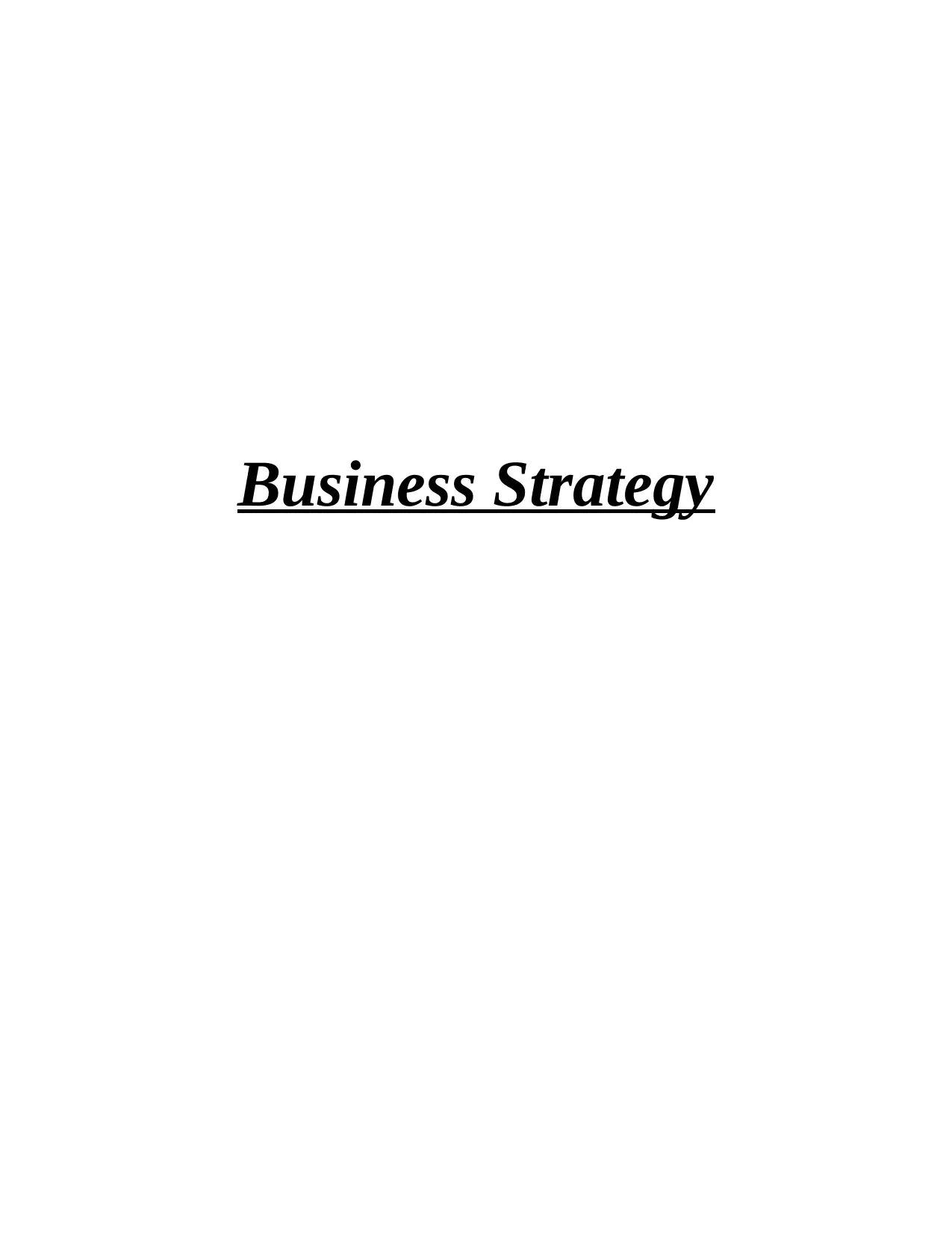
Business Strategy
Paraphrase This Document
Need a fresh take? Get an instant paraphrase of this document with our AI Paraphraser
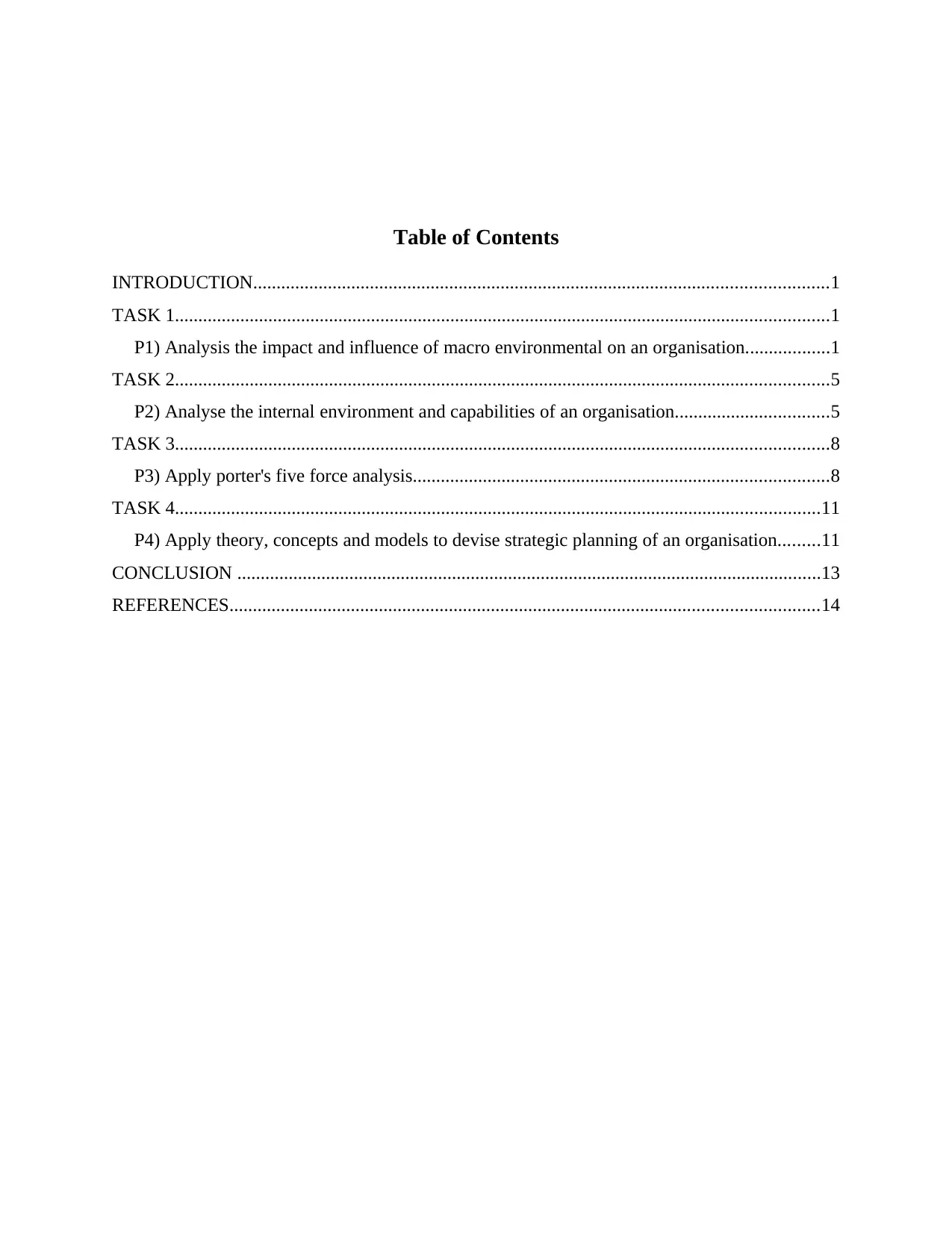
Table of Contents
INTRODUCTION...........................................................................................................................1
TASK 1............................................................................................................................................1
P1) Analysis the impact and influence of macro environmental on an organisation..................1
TASK 2............................................................................................................................................5
P2) Analyse the internal environment and capabilities of an organisation.................................5
TASK 3............................................................................................................................................8
P3) Apply porter's five force analysis.........................................................................................8
TASK 4..........................................................................................................................................11
P4) Apply theory, concepts and models to devise strategic planning of an organisation.........11
CONCLUSION .............................................................................................................................13
REFERENCES..............................................................................................................................14
INTRODUCTION...........................................................................................................................1
TASK 1............................................................................................................................................1
P1) Analysis the impact and influence of macro environmental on an organisation..................1
TASK 2............................................................................................................................................5
P2) Analyse the internal environment and capabilities of an organisation.................................5
TASK 3............................................................................................................................................8
P3) Apply porter's five force analysis.........................................................................................8
TASK 4..........................................................................................................................................11
P4) Apply theory, concepts and models to devise strategic planning of an organisation.........11
CONCLUSION .............................................................................................................................13
REFERENCES..............................................................................................................................14
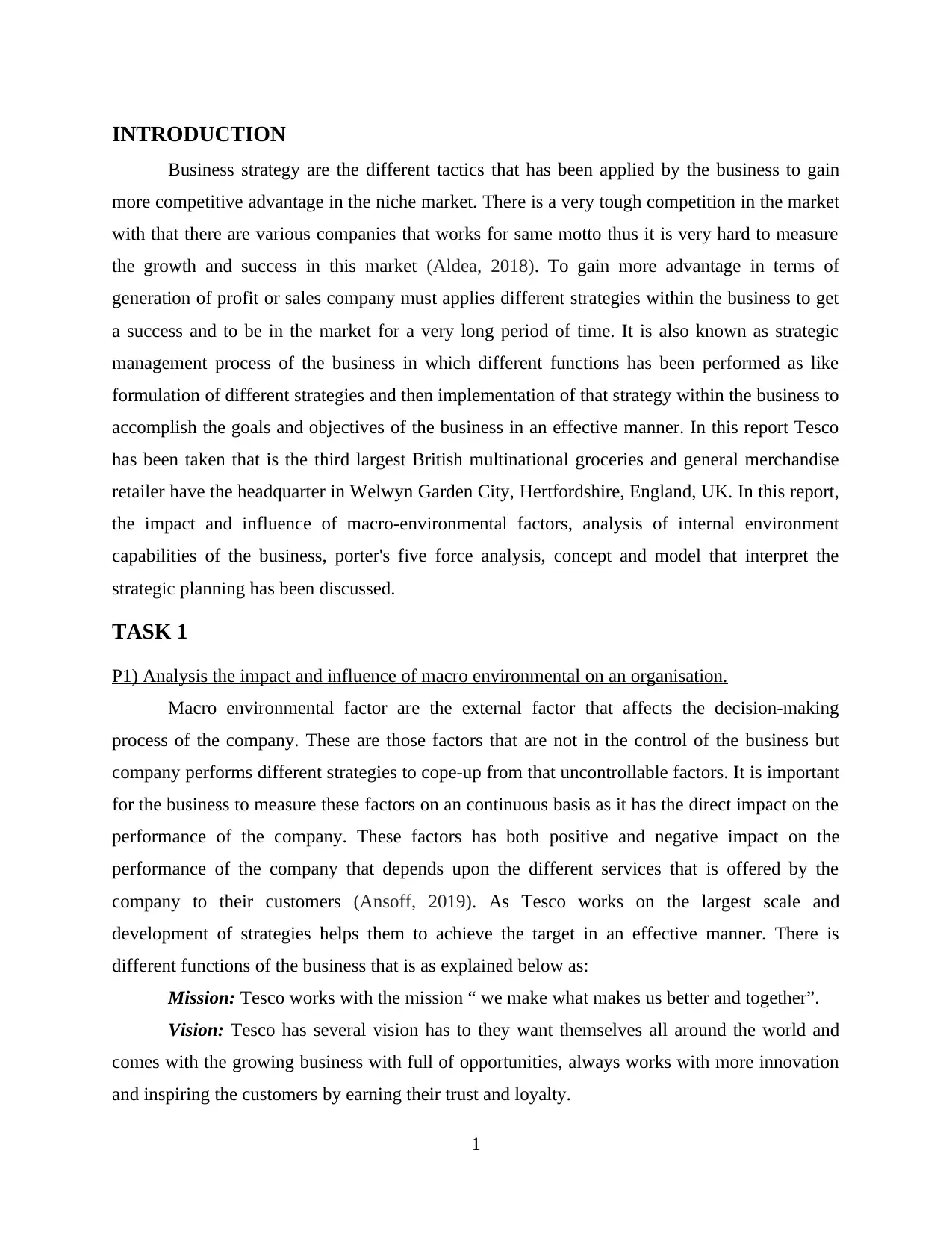
INTRODUCTION
Business strategy are the different tactics that has been applied by the business to gain
more competitive advantage in the niche market. There is a very tough competition in the market
with that there are various companies that works for same motto thus it is very hard to measure
the growth and success in this market (Aldea, 2018). To gain more advantage in terms of
generation of profit or sales company must applies different strategies within the business to get
a success and to be in the market for a very long period of time. It is also known as strategic
management process of the business in which different functions has been performed as like
formulation of different strategies and then implementation of that strategy within the business to
accomplish the goals and objectives of the business in an effective manner. In this report Tesco
has been taken that is the third largest British multinational groceries and general merchandise
retailer have the headquarter in Welwyn Garden City, Hertfordshire, England, UK. In this report,
the impact and influence of macro-environmental factors, analysis of internal environment
capabilities of the business, porter's five force analysis, concept and model that interpret the
strategic planning has been discussed.
TASK 1
P1) Analysis the impact and influence of macro environmental on an organisation.
Macro environmental factor are the external factor that affects the decision-making
process of the company. These are those factors that are not in the control of the business but
company performs different strategies to cope-up from that uncontrollable factors. It is important
for the business to measure these factors on an continuous basis as it has the direct impact on the
performance of the company. These factors has both positive and negative impact on the
performance of the company that depends upon the different services that is offered by the
company to their customers (Ansoff, 2019). As Tesco works on the largest scale and
development of strategies helps them to achieve the target in an effective manner. There is
different functions of the business that is as explained below as:
Mission: Tesco works with the mission “ we make what makes us better and together”.
Vision: Tesco has several vision has to they want themselves all around the world and
comes with the growing business with full of opportunities, always works with more innovation
and inspiring the customers by earning their trust and loyalty.
1
Business strategy are the different tactics that has been applied by the business to gain
more competitive advantage in the niche market. There is a very tough competition in the market
with that there are various companies that works for same motto thus it is very hard to measure
the growth and success in this market (Aldea, 2018). To gain more advantage in terms of
generation of profit or sales company must applies different strategies within the business to get
a success and to be in the market for a very long period of time. It is also known as strategic
management process of the business in which different functions has been performed as like
formulation of different strategies and then implementation of that strategy within the business to
accomplish the goals and objectives of the business in an effective manner. In this report Tesco
has been taken that is the third largest British multinational groceries and general merchandise
retailer have the headquarter in Welwyn Garden City, Hertfordshire, England, UK. In this report,
the impact and influence of macro-environmental factors, analysis of internal environment
capabilities of the business, porter's five force analysis, concept and model that interpret the
strategic planning has been discussed.
TASK 1
P1) Analysis the impact and influence of macro environmental on an organisation.
Macro environmental factor are the external factor that affects the decision-making
process of the company. These are those factors that are not in the control of the business but
company performs different strategies to cope-up from that uncontrollable factors. It is important
for the business to measure these factors on an continuous basis as it has the direct impact on the
performance of the company. These factors has both positive and negative impact on the
performance of the company that depends upon the different services that is offered by the
company to their customers (Ansoff, 2019). As Tesco works on the largest scale and
development of strategies helps them to achieve the target in an effective manner. There is
different functions of the business that is as explained below as:
Mission: Tesco works with the mission “ we make what makes us better and together”.
Vision: Tesco has several vision has to they want themselves all around the world and
comes with the growing business with full of opportunities, always works with more innovation
and inspiring the customers by earning their trust and loyalty.
1
⊘ This is a preview!⊘
Do you want full access?
Subscribe today to unlock all pages.

Trusted by 1+ million students worldwide
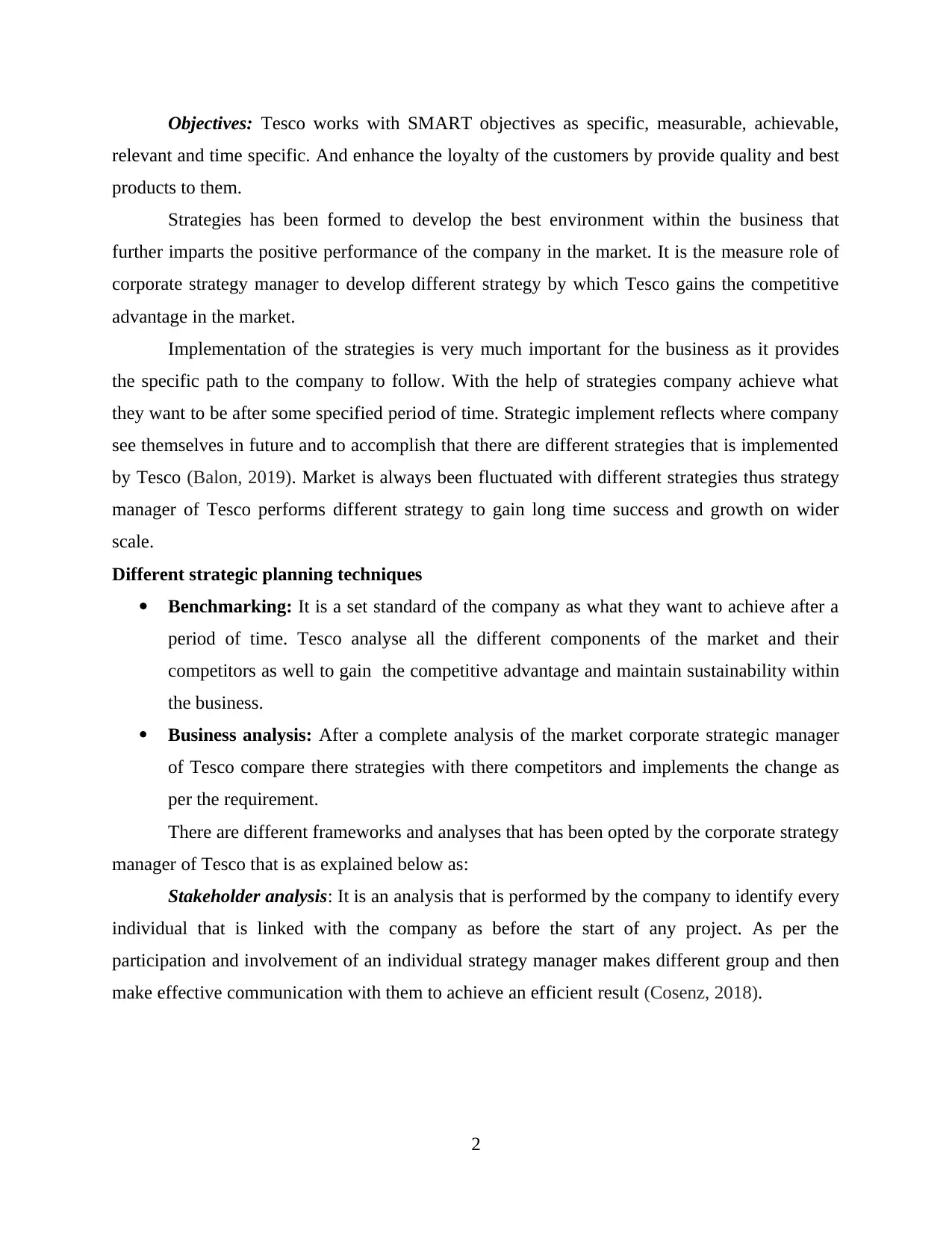
Objectives: Tesco works with SMART objectives as specific, measurable, achievable,
relevant and time specific. And enhance the loyalty of the customers by provide quality and best
products to them.
Strategies has been formed to develop the best environment within the business that
further imparts the positive performance of the company in the market. It is the measure role of
corporate strategy manager to develop different strategy by which Tesco gains the competitive
advantage in the market.
Implementation of the strategies is very much important for the business as it provides
the specific path to the company to follow. With the help of strategies company achieve what
they want to be after some specified period of time. Strategic implement reflects where company
see themselves in future and to accomplish that there are different strategies that is implemented
by Tesco (Balon, 2019). Market is always been fluctuated with different strategies thus strategy
manager of Tesco performs different strategy to gain long time success and growth on wider
scale.
Different strategic planning techniques
Benchmarking: It is a set standard of the company as what they want to achieve after a
period of time. Tesco analyse all the different components of the market and their
competitors as well to gain the competitive advantage and maintain sustainability within
the business.
Business analysis: After a complete analysis of the market corporate strategic manager
of Tesco compare there strategies with there competitors and implements the change as
per the requirement.
There are different frameworks and analyses that has been opted by the corporate strategy
manager of Tesco that is as explained below as:
Stakeholder analysis: It is an analysis that is performed by the company to identify every
individual that is linked with the company as before the start of any project. As per the
participation and involvement of an individual strategy manager makes different group and then
make effective communication with them to achieve an efficient result (Cosenz, 2018).
2
relevant and time specific. And enhance the loyalty of the customers by provide quality and best
products to them.
Strategies has been formed to develop the best environment within the business that
further imparts the positive performance of the company in the market. It is the measure role of
corporate strategy manager to develop different strategy by which Tesco gains the competitive
advantage in the market.
Implementation of the strategies is very much important for the business as it provides
the specific path to the company to follow. With the help of strategies company achieve what
they want to be after some specified period of time. Strategic implement reflects where company
see themselves in future and to accomplish that there are different strategies that is implemented
by Tesco (Balon, 2019). Market is always been fluctuated with different strategies thus strategy
manager of Tesco performs different strategy to gain long time success and growth on wider
scale.
Different strategic planning techniques
Benchmarking: It is a set standard of the company as what they want to achieve after a
period of time. Tesco analyse all the different components of the market and their
competitors as well to gain the competitive advantage and maintain sustainability within
the business.
Business analysis: After a complete analysis of the market corporate strategic manager
of Tesco compare there strategies with there competitors and implements the change as
per the requirement.
There are different frameworks and analyses that has been opted by the corporate strategy
manager of Tesco that is as explained below as:
Stakeholder analysis: It is an analysis that is performed by the company to identify every
individual that is linked with the company as before the start of any project. As per the
participation and involvement of an individual strategy manager makes different group and then
make effective communication with them to achieve an efficient result (Cosenz, 2018).
2
Paraphrase This Document
Need a fresh take? Get an instant paraphrase of this document with our AI Paraphraser
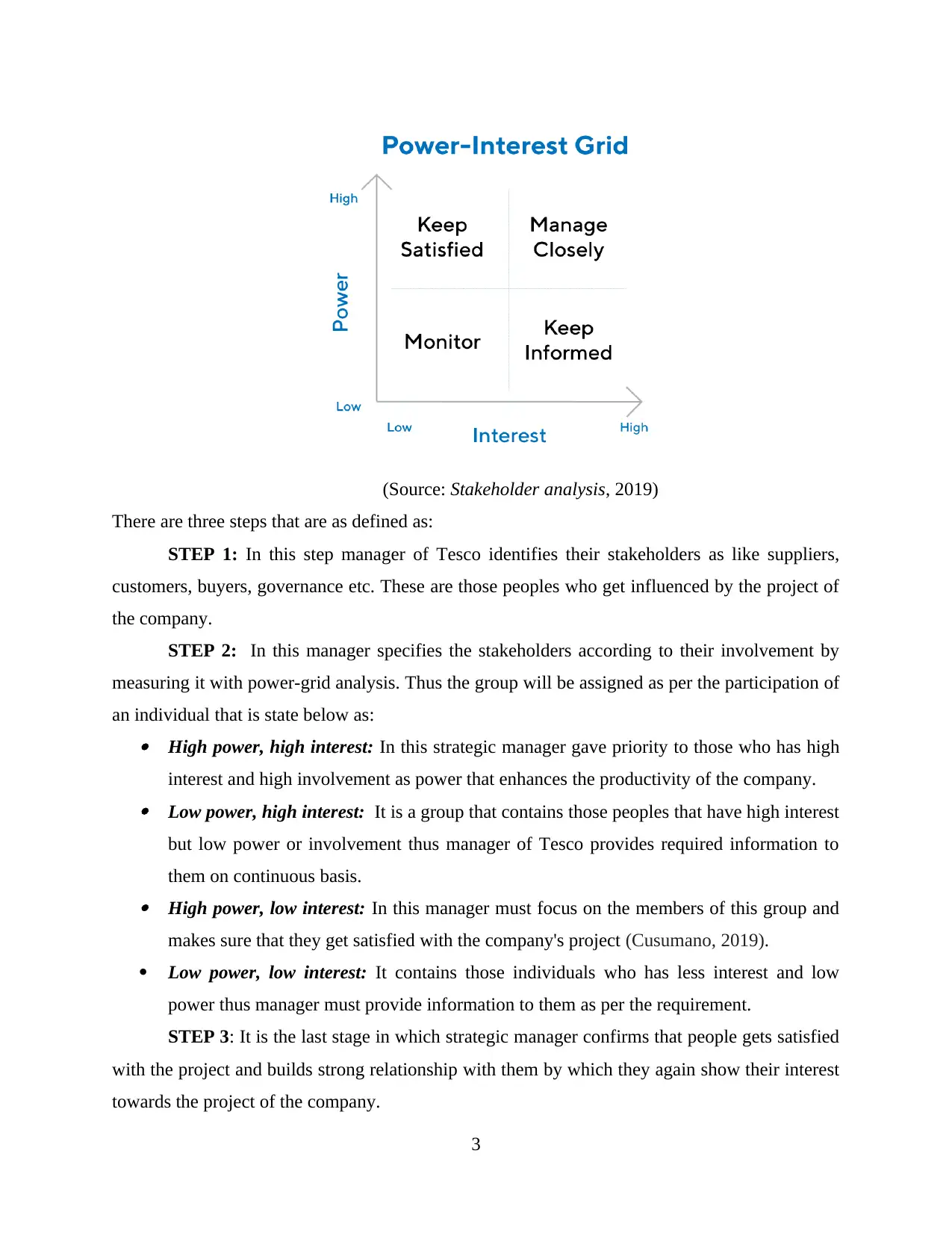
(Source: Stakeholder analysis, 2019)
There are three steps that are as defined as:
STEP 1: In this step manager of Tesco identifies their stakeholders as like suppliers,
customers, buyers, governance etc. These are those peoples who get influenced by the project of
the company.
STEP 2: In this manager specifies the stakeholders according to their involvement by
measuring it with power-grid analysis. Thus the group will be assigned as per the participation of
an individual that is state below as: High power, high interest: In this strategic manager gave priority to those who has high
interest and high involvement as power that enhances the productivity of the company. Low power, high interest: It is a group that contains those peoples that have high interest
but low power or involvement thus manager of Tesco provides required information to
them on continuous basis. High power, low interest: In this manager must focus on the members of this group and
makes sure that they get satisfied with the company's project (Cusumano, 2019).
Low power, low interest: It contains those individuals who has less interest and low
power thus manager must provide information to them as per the requirement.
STEP 3: It is the last stage in which strategic manager confirms that people gets satisfied
with the project and builds strong relationship with them by which they again show their interest
towards the project of the company.
3
There are three steps that are as defined as:
STEP 1: In this step manager of Tesco identifies their stakeholders as like suppliers,
customers, buyers, governance etc. These are those peoples who get influenced by the project of
the company.
STEP 2: In this manager specifies the stakeholders according to their involvement by
measuring it with power-grid analysis. Thus the group will be assigned as per the participation of
an individual that is state below as: High power, high interest: In this strategic manager gave priority to those who has high
interest and high involvement as power that enhances the productivity of the company. Low power, high interest: It is a group that contains those peoples that have high interest
but low power or involvement thus manager of Tesco provides required information to
them on continuous basis. High power, low interest: In this manager must focus on the members of this group and
makes sure that they get satisfied with the company's project (Cusumano, 2019).
Low power, low interest: It contains those individuals who has less interest and low
power thus manager must provide information to them as per the requirement.
STEP 3: It is the last stage in which strategic manager confirms that people gets satisfied
with the project and builds strong relationship with them by which they again show their interest
towards the project of the company.
3
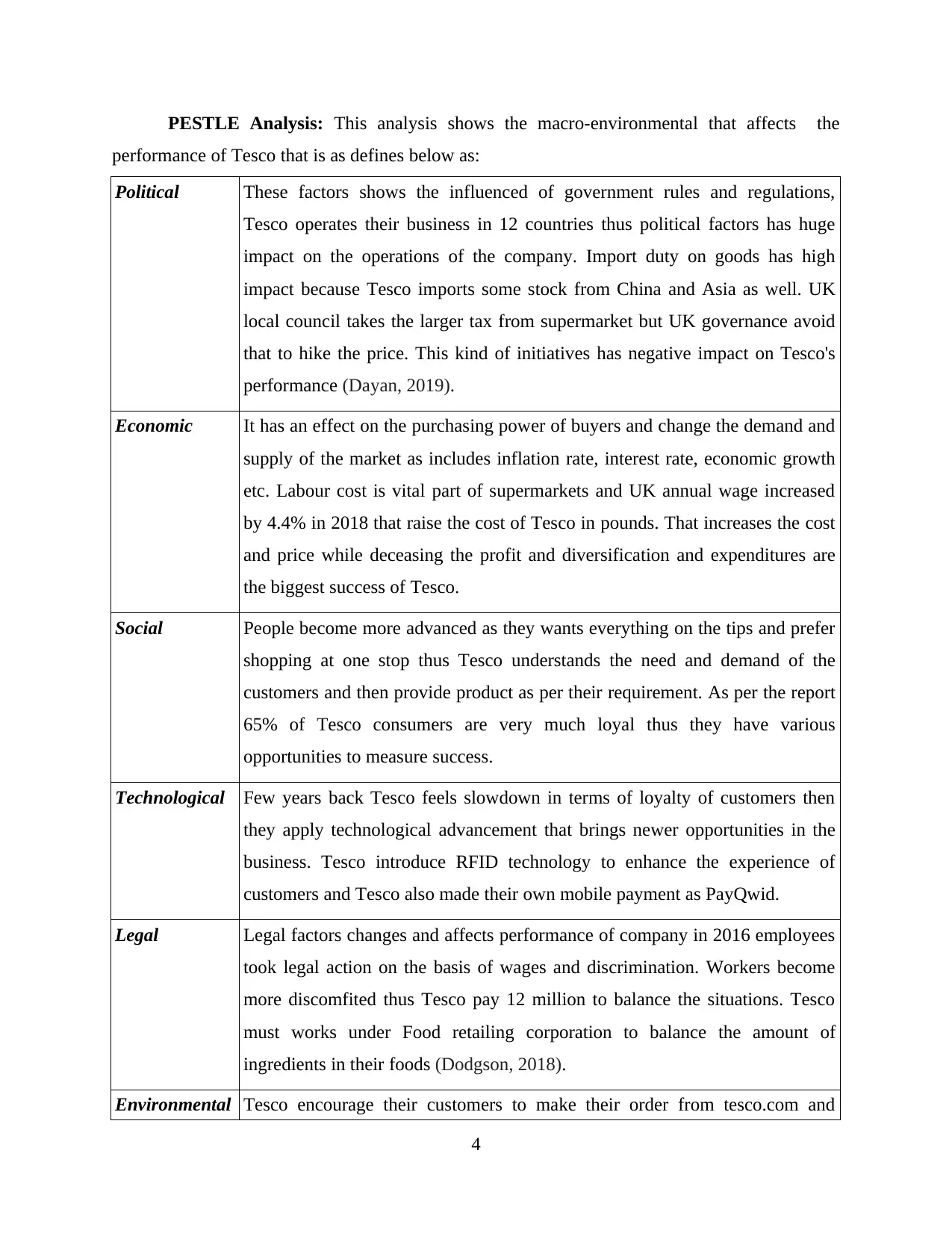
PESTLE Analysis: This analysis shows the macro-environmental that affects the
performance of Tesco that is as defines below as:
Political These factors shows the influenced of government rules and regulations,
Tesco operates their business in 12 countries thus political factors has huge
impact on the operations of the company. Import duty on goods has high
impact because Tesco imports some stock from China and Asia as well. UK
local council takes the larger tax from supermarket but UK governance avoid
that to hike the price. This kind of initiatives has negative impact on Tesco's
performance (Dayan, 2019).
Economic It has an effect on the purchasing power of buyers and change the demand and
supply of the market as includes inflation rate, interest rate, economic growth
etc. Labour cost is vital part of supermarkets and UK annual wage increased
by 4.4% in 2018 that raise the cost of Tesco in pounds. That increases the cost
and price while deceasing the profit and diversification and expenditures are
the biggest success of Tesco.
Social People become more advanced as they wants everything on the tips and prefer
shopping at one stop thus Tesco understands the need and demand of the
customers and then provide product as per their requirement. As per the report
65% of Tesco consumers are very much loyal thus they have various
opportunities to measure success.
Technological Few years back Tesco feels slowdown in terms of loyalty of customers then
they apply technological advancement that brings newer opportunities in the
business. Tesco introduce RFID technology to enhance the experience of
customers and Tesco also made their own mobile payment as PayQwid.
Legal Legal factors changes and affects performance of company in 2016 employees
took legal action on the basis of wages and discrimination. Workers become
more discomfited thus Tesco pay 12 million to balance the situations. Tesco
must works under Food retailing corporation to balance the amount of
ingredients in their foods (Dodgson, 2018).
Environmental Tesco encourage their customers to make their order from tesco.com and
4
performance of Tesco that is as defines below as:
Political These factors shows the influenced of government rules and regulations,
Tesco operates their business in 12 countries thus political factors has huge
impact on the operations of the company. Import duty on goods has high
impact because Tesco imports some stock from China and Asia as well. UK
local council takes the larger tax from supermarket but UK governance avoid
that to hike the price. This kind of initiatives has negative impact on Tesco's
performance (Dayan, 2019).
Economic It has an effect on the purchasing power of buyers and change the demand and
supply of the market as includes inflation rate, interest rate, economic growth
etc. Labour cost is vital part of supermarkets and UK annual wage increased
by 4.4% in 2018 that raise the cost of Tesco in pounds. That increases the cost
and price while deceasing the profit and diversification and expenditures are
the biggest success of Tesco.
Social People become more advanced as they wants everything on the tips and prefer
shopping at one stop thus Tesco understands the need and demand of the
customers and then provide product as per their requirement. As per the report
65% of Tesco consumers are very much loyal thus they have various
opportunities to measure success.
Technological Few years back Tesco feels slowdown in terms of loyalty of customers then
they apply technological advancement that brings newer opportunities in the
business. Tesco introduce RFID technology to enhance the experience of
customers and Tesco also made their own mobile payment as PayQwid.
Legal Legal factors changes and affects performance of company in 2016 employees
took legal action on the basis of wages and discrimination. Workers become
more discomfited thus Tesco pay 12 million to balance the situations. Tesco
must works under Food retailing corporation to balance the amount of
ingredients in their foods (Dodgson, 2018).
Environmental Tesco encourage their customers to make their order from tesco.com and
4
⊘ This is a preview!⊘
Do you want full access?
Subscribe today to unlock all pages.

Trusted by 1+ million students worldwide
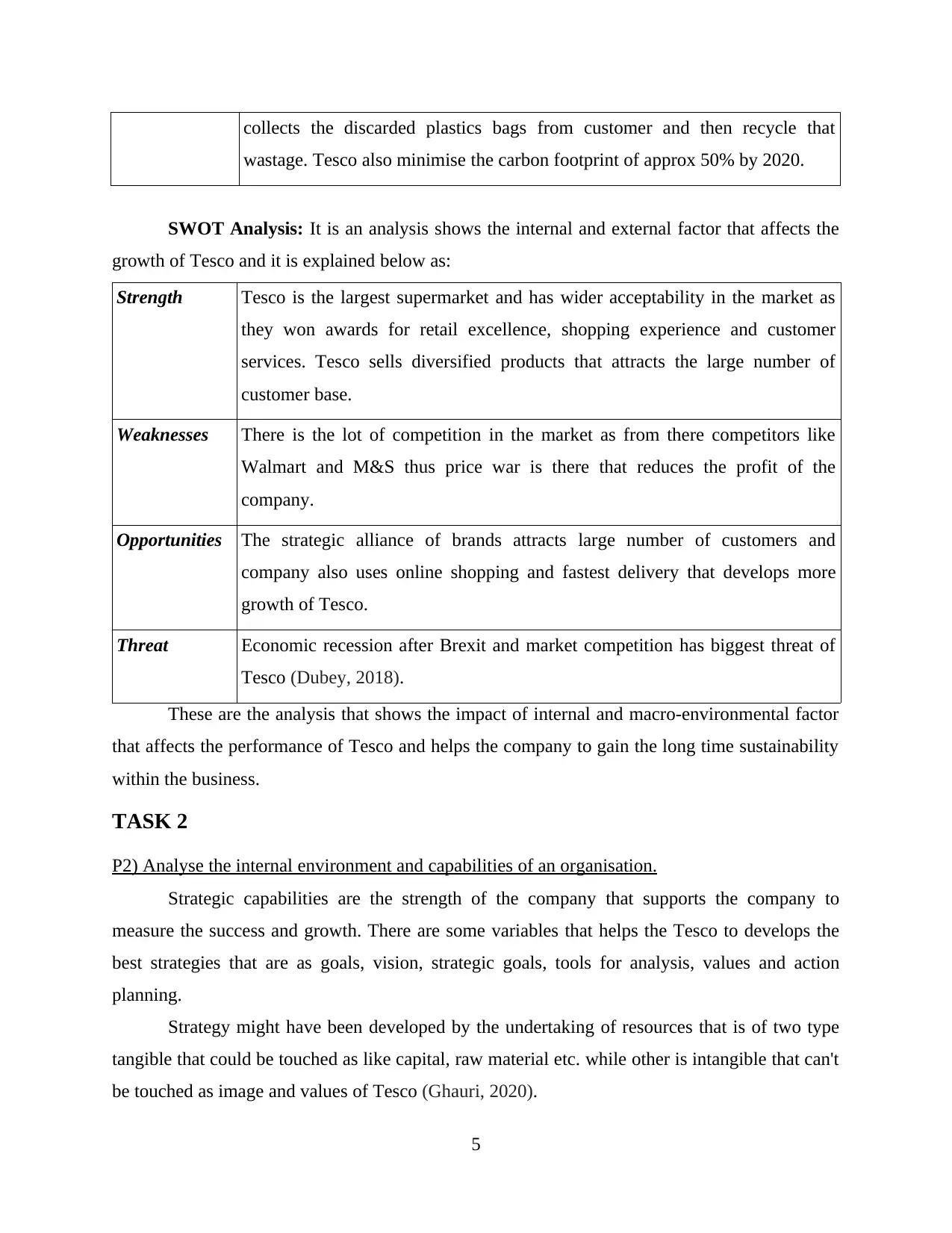
collects the discarded plastics bags from customer and then recycle that
wastage. Tesco also minimise the carbon footprint of approx 50% by 2020.
SWOT Analysis: It is an analysis shows the internal and external factor that affects the
growth of Tesco and it is explained below as:
Strength Tesco is the largest supermarket and has wider acceptability in the market as
they won awards for retail excellence, shopping experience and customer
services. Tesco sells diversified products that attracts the large number of
customer base.
Weaknesses There is the lot of competition in the market as from there competitors like
Walmart and M&S thus price war is there that reduces the profit of the
company.
Opportunities The strategic alliance of brands attracts large number of customers and
company also uses online shopping and fastest delivery that develops more
growth of Tesco.
Threat Economic recession after Brexit and market competition has biggest threat of
Tesco (Dubey, 2018).
These are the analysis that shows the impact of internal and macro-environmental factor
that affects the performance of Tesco and helps the company to gain the long time sustainability
within the business.
TASK 2
P2) Analyse the internal environment and capabilities of an organisation.
Strategic capabilities are the strength of the company that supports the company to
measure the success and growth. There are some variables that helps the Tesco to develops the
best strategies that are as goals, vision, strategic goals, tools for analysis, values and action
planning.
Strategy might have been developed by the undertaking of resources that is of two type
tangible that could be touched as like capital, raw material etc. while other is intangible that can't
be touched as image and values of Tesco (Ghauri, 2020).
5
wastage. Tesco also minimise the carbon footprint of approx 50% by 2020.
SWOT Analysis: It is an analysis shows the internal and external factor that affects the
growth of Tesco and it is explained below as:
Strength Tesco is the largest supermarket and has wider acceptability in the market as
they won awards for retail excellence, shopping experience and customer
services. Tesco sells diversified products that attracts the large number of
customer base.
Weaknesses There is the lot of competition in the market as from there competitors like
Walmart and M&S thus price war is there that reduces the profit of the
company.
Opportunities The strategic alliance of brands attracts large number of customers and
company also uses online shopping and fastest delivery that develops more
growth of Tesco.
Threat Economic recession after Brexit and market competition has biggest threat of
Tesco (Dubey, 2018).
These are the analysis that shows the impact of internal and macro-environmental factor
that affects the performance of Tesco and helps the company to gain the long time sustainability
within the business.
TASK 2
P2) Analyse the internal environment and capabilities of an organisation.
Strategic capabilities are the strength of the company that supports the company to
measure the success and growth. There are some variables that helps the Tesco to develops the
best strategies that are as goals, vision, strategic goals, tools for analysis, values and action
planning.
Strategy might have been developed by the undertaking of resources that is of two type
tangible that could be touched as like capital, raw material etc. while other is intangible that can't
be touched as image and values of Tesco (Ghauri, 2020).
5
Paraphrase This Document
Need a fresh take? Get an instant paraphrase of this document with our AI Paraphraser
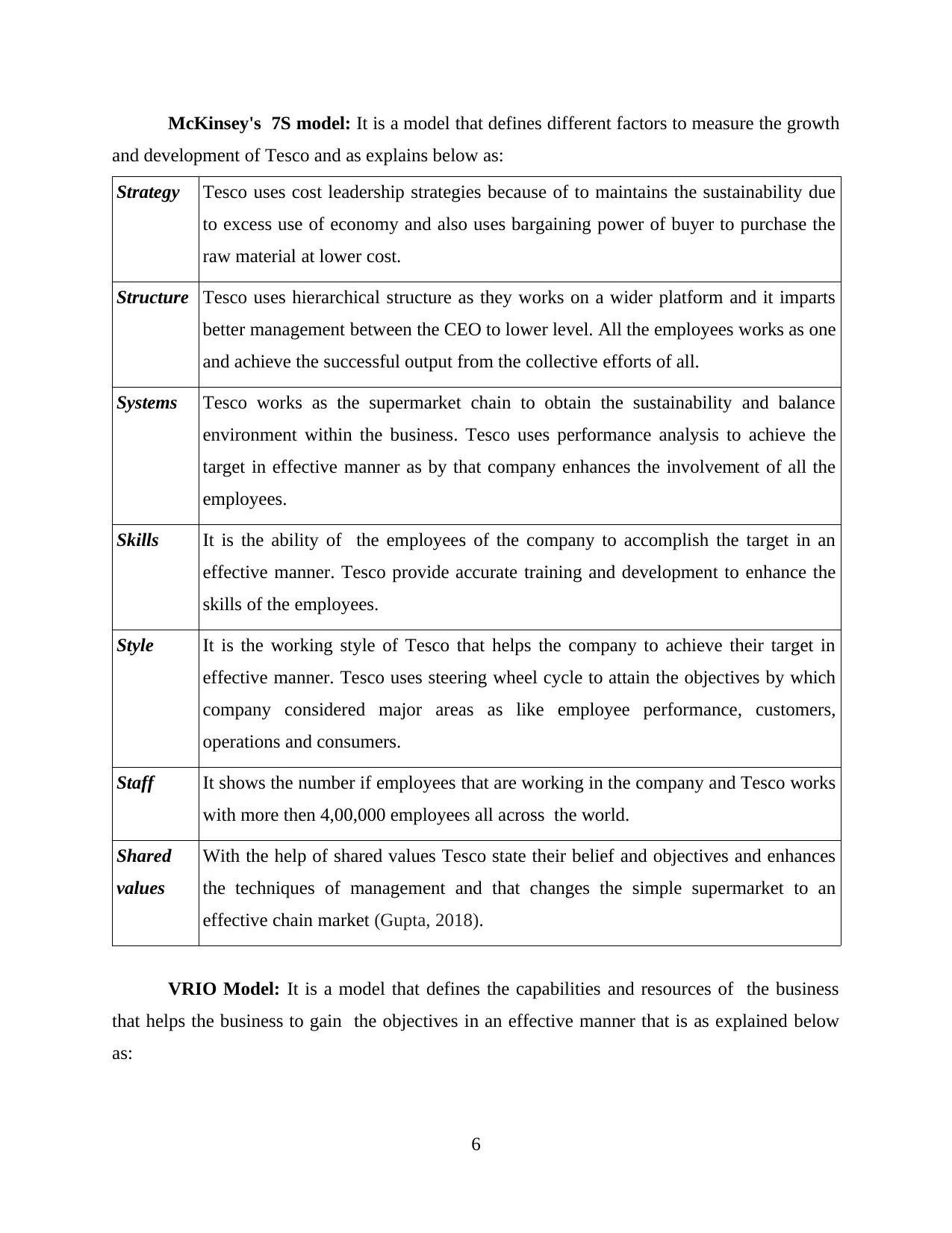
McKinsey's 7S model: It is a model that defines different factors to measure the growth
and development of Tesco and as explains below as:
Strategy Tesco uses cost leadership strategies because of to maintains the sustainability due
to excess use of economy and also uses bargaining power of buyer to purchase the
raw material at lower cost.
Structure Tesco uses hierarchical structure as they works on a wider platform and it imparts
better management between the CEO to lower level. All the employees works as one
and achieve the successful output from the collective efforts of all.
Systems Tesco works as the supermarket chain to obtain the sustainability and balance
environment within the business. Tesco uses performance analysis to achieve the
target in effective manner as by that company enhances the involvement of all the
employees.
Skills It is the ability of the employees of the company to accomplish the target in an
effective manner. Tesco provide accurate training and development to enhance the
skills of the employees.
Style It is the working style of Tesco that helps the company to achieve their target in
effective manner. Tesco uses steering wheel cycle to attain the objectives by which
company considered major areas as like employee performance, customers,
operations and consumers.
Staff It shows the number if employees that are working in the company and Tesco works
with more then 4,00,000 employees all across the world.
Shared
values
With the help of shared values Tesco state their belief and objectives and enhances
the techniques of management and that changes the simple supermarket to an
effective chain market (Gupta, 2018).
VRIO Model: It is a model that defines the capabilities and resources of the business
that helps the business to gain the objectives in an effective manner that is as explained below
as:
6
and development of Tesco and as explains below as:
Strategy Tesco uses cost leadership strategies because of to maintains the sustainability due
to excess use of economy and also uses bargaining power of buyer to purchase the
raw material at lower cost.
Structure Tesco uses hierarchical structure as they works on a wider platform and it imparts
better management between the CEO to lower level. All the employees works as one
and achieve the successful output from the collective efforts of all.
Systems Tesco works as the supermarket chain to obtain the sustainability and balance
environment within the business. Tesco uses performance analysis to achieve the
target in effective manner as by that company enhances the involvement of all the
employees.
Skills It is the ability of the employees of the company to accomplish the target in an
effective manner. Tesco provide accurate training and development to enhance the
skills of the employees.
Style It is the working style of Tesco that helps the company to achieve their target in
effective manner. Tesco uses steering wheel cycle to attain the objectives by which
company considered major areas as like employee performance, customers,
operations and consumers.
Staff It shows the number if employees that are working in the company and Tesco works
with more then 4,00,000 employees all across the world.
Shared
values
With the help of shared values Tesco state their belief and objectives and enhances
the techniques of management and that changes the simple supermarket to an
effective chain market (Gupta, 2018).
VRIO Model: It is a model that defines the capabilities and resources of the business
that helps the business to gain the objectives in an effective manner that is as explained below
as:
6
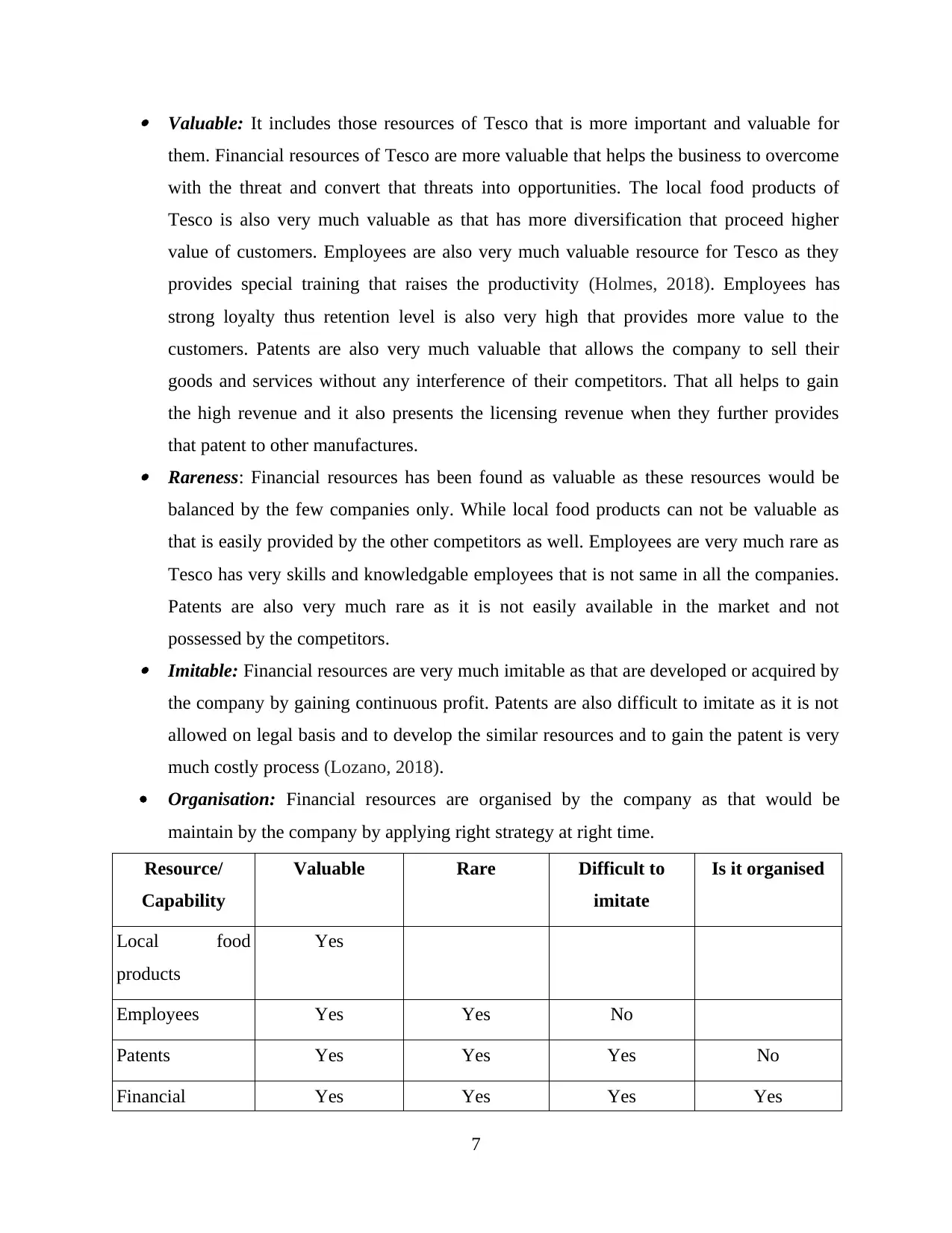
Valuable: It includes those resources of Tesco that is more important and valuable for
them. Financial resources of Tesco are more valuable that helps the business to overcome
with the threat and convert that threats into opportunities. The local food products of
Tesco is also very much valuable as that has more diversification that proceed higher
value of customers. Employees are also very much valuable resource for Tesco as they
provides special training that raises the productivity (Holmes, 2018). Employees has
strong loyalty thus retention level is also very high that provides more value to the
customers. Patents are also very much valuable that allows the company to sell their
goods and services without any interference of their competitors. That all helps to gain
the high revenue and it also presents the licensing revenue when they further provides
that patent to other manufactures. Rareness: Financial resources has been found as valuable as these resources would be
balanced by the few companies only. While local food products can not be valuable as
that is easily provided by the other competitors as well. Employees are very much rare as
Tesco has very skills and knowledgable employees that is not same in all the companies.
Patents are also very much rare as it is not easily available in the market and not
possessed by the competitors. Imitable: Financial resources are very much imitable as that are developed or acquired by
the company by gaining continuous profit. Patents are also difficult to imitate as it is not
allowed on legal basis and to develop the similar resources and to gain the patent is very
much costly process (Lozano, 2018).
Organisation: Financial resources are organised by the company as that would be
maintain by the company by applying right strategy at right time.
Resource/
Capability
Valuable Rare Difficult to
imitate
Is it organised
Local food
products
Yes
Employees Yes Yes No
Patents Yes Yes Yes No
Financial Yes Yes Yes Yes
7
them. Financial resources of Tesco are more valuable that helps the business to overcome
with the threat and convert that threats into opportunities. The local food products of
Tesco is also very much valuable as that has more diversification that proceed higher
value of customers. Employees are also very much valuable resource for Tesco as they
provides special training that raises the productivity (Holmes, 2018). Employees has
strong loyalty thus retention level is also very high that provides more value to the
customers. Patents are also very much valuable that allows the company to sell their
goods and services without any interference of their competitors. That all helps to gain
the high revenue and it also presents the licensing revenue when they further provides
that patent to other manufactures. Rareness: Financial resources has been found as valuable as these resources would be
balanced by the few companies only. While local food products can not be valuable as
that is easily provided by the other competitors as well. Employees are very much rare as
Tesco has very skills and knowledgable employees that is not same in all the companies.
Patents are also very much rare as it is not easily available in the market and not
possessed by the competitors. Imitable: Financial resources are very much imitable as that are developed or acquired by
the company by gaining continuous profit. Patents are also difficult to imitate as it is not
allowed on legal basis and to develop the similar resources and to gain the patent is very
much costly process (Lozano, 2018).
Organisation: Financial resources are organised by the company as that would be
maintain by the company by applying right strategy at right time.
Resource/
Capability
Valuable Rare Difficult to
imitate
Is it organised
Local food
products
Yes
Employees Yes Yes No
Patents Yes Yes Yes No
Financial Yes Yes Yes Yes
7
⊘ This is a preview!⊘
Do you want full access?
Subscribe today to unlock all pages.

Trusted by 1+ million students worldwide
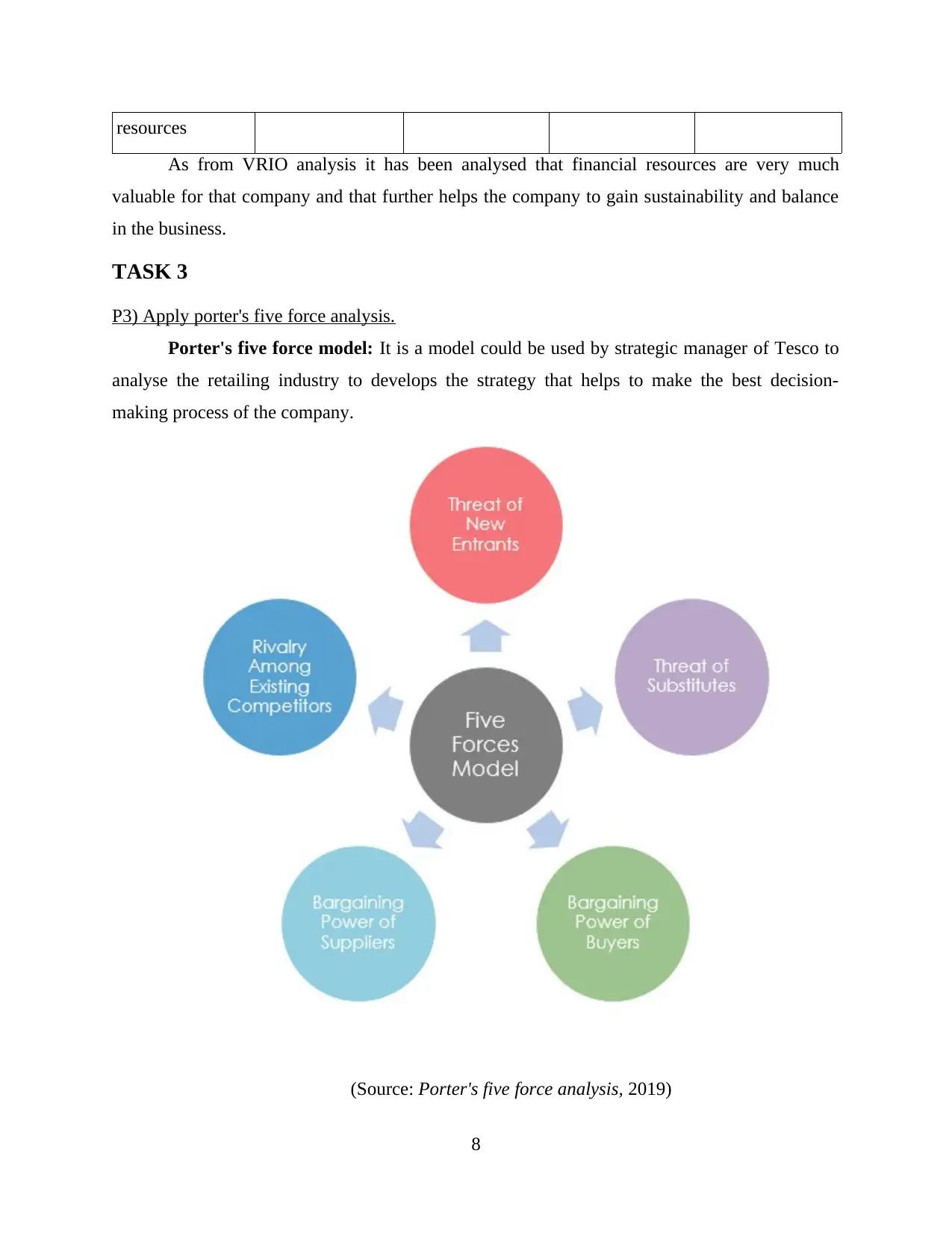
resources
As from VRIO analysis it has been analysed that financial resources are very much
valuable for that company and that further helps the company to gain sustainability and balance
in the business.
TASK 3
P3) Apply porter's five force analysis.
Porter's five force model: It is a model could be used by strategic manager of Tesco to
analyse the retailing industry to develops the strategy that helps to make the best decision-
making process of the company.
(Source: Porter's five force analysis, 2019)
8
As from VRIO analysis it has been analysed that financial resources are very much
valuable for that company and that further helps the company to gain sustainability and balance
in the business.
TASK 3
P3) Apply porter's five force analysis.
Porter's five force model: It is a model could be used by strategic manager of Tesco to
analyse the retailing industry to develops the strategy that helps to make the best decision-
making process of the company.
(Source: Porter's five force analysis, 2019)
8
Paraphrase This Document
Need a fresh take? Get an instant paraphrase of this document with our AI Paraphraser
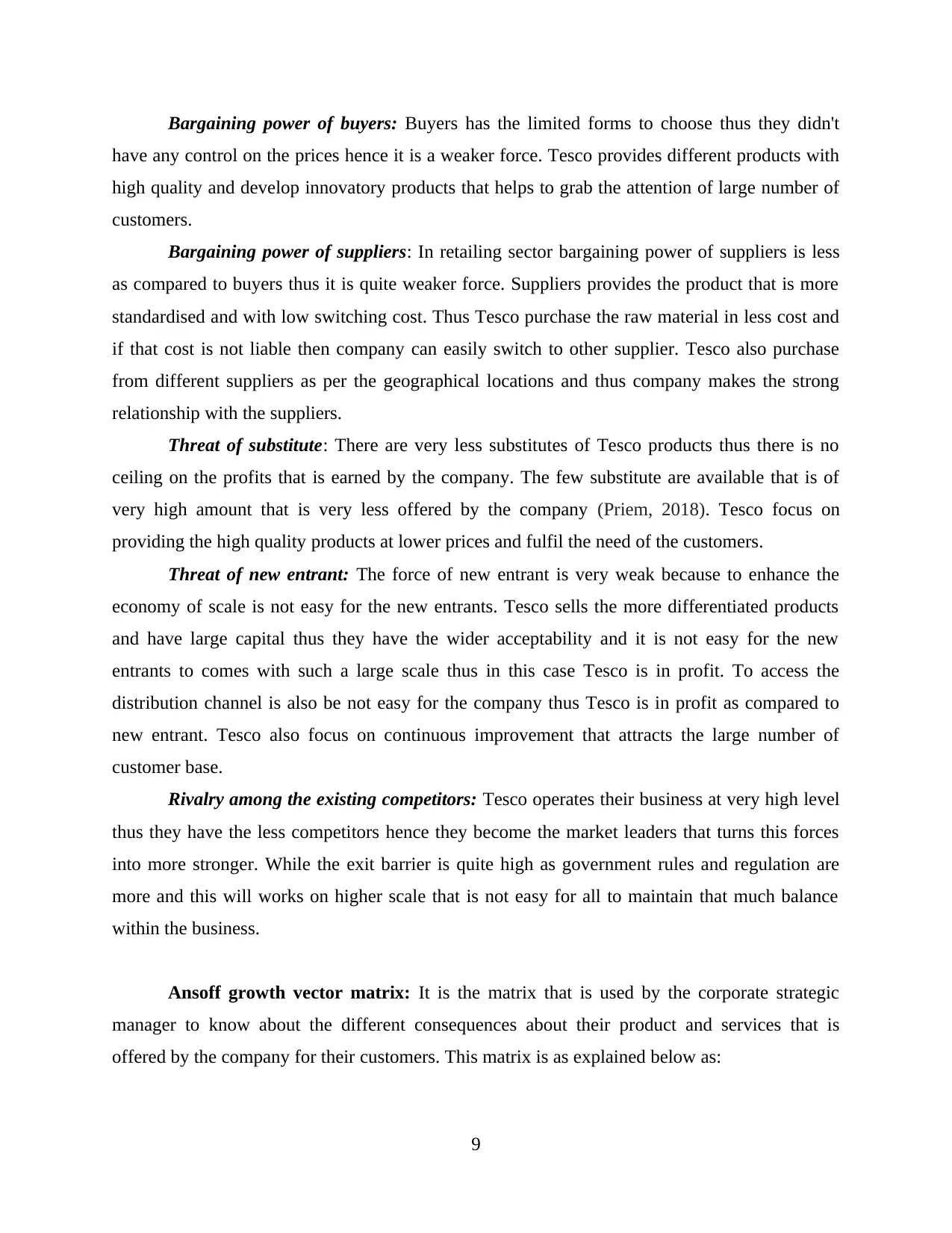
Bargaining power of buyers: Buyers has the limited forms to choose thus they didn't
have any control on the prices hence it is a weaker force. Tesco provides different products with
high quality and develop innovatory products that helps to grab the attention of large number of
customers.
Bargaining power of suppliers: In retailing sector bargaining power of suppliers is less
as compared to buyers thus it is quite weaker force. Suppliers provides the product that is more
standardised and with low switching cost. Thus Tesco purchase the raw material in less cost and
if that cost is not liable then company can easily switch to other supplier. Tesco also purchase
from different suppliers as per the geographical locations and thus company makes the strong
relationship with the suppliers.
Threat of substitute: There are very less substitutes of Tesco products thus there is no
ceiling on the profits that is earned by the company. The few substitute are available that is of
very high amount that is very less offered by the company (Priem, 2018). Tesco focus on
providing the high quality products at lower prices and fulfil the need of the customers.
Threat of new entrant: The force of new entrant is very weak because to enhance the
economy of scale is not easy for the new entrants. Tesco sells the more differentiated products
and have large capital thus they have the wider acceptability and it is not easy for the new
entrants to comes with such a large scale thus in this case Tesco is in profit. To access the
distribution channel is also be not easy for the company thus Tesco is in profit as compared to
new entrant. Tesco also focus on continuous improvement that attracts the large number of
customer base.
Rivalry among the existing competitors: Tesco operates their business at very high level
thus they have the less competitors hence they become the market leaders that turns this forces
into more stronger. While the exit barrier is quite high as government rules and regulation are
more and this will works on higher scale that is not easy for all to maintain that much balance
within the business.
Ansoff growth vector matrix: It is the matrix that is used by the corporate strategic
manager to know about the different consequences about their product and services that is
offered by the company for their customers. This matrix is as explained below as:
9
have any control on the prices hence it is a weaker force. Tesco provides different products with
high quality and develop innovatory products that helps to grab the attention of large number of
customers.
Bargaining power of suppliers: In retailing sector bargaining power of suppliers is less
as compared to buyers thus it is quite weaker force. Suppliers provides the product that is more
standardised and with low switching cost. Thus Tesco purchase the raw material in less cost and
if that cost is not liable then company can easily switch to other supplier. Tesco also purchase
from different suppliers as per the geographical locations and thus company makes the strong
relationship with the suppliers.
Threat of substitute: There are very less substitutes of Tesco products thus there is no
ceiling on the profits that is earned by the company. The few substitute are available that is of
very high amount that is very less offered by the company (Priem, 2018). Tesco focus on
providing the high quality products at lower prices and fulfil the need of the customers.
Threat of new entrant: The force of new entrant is very weak because to enhance the
economy of scale is not easy for the new entrants. Tesco sells the more differentiated products
and have large capital thus they have the wider acceptability and it is not easy for the new
entrants to comes with such a large scale thus in this case Tesco is in profit. To access the
distribution channel is also be not easy for the company thus Tesco is in profit as compared to
new entrant. Tesco also focus on continuous improvement that attracts the large number of
customer base.
Rivalry among the existing competitors: Tesco operates their business at very high level
thus they have the less competitors hence they become the market leaders that turns this forces
into more stronger. While the exit barrier is quite high as government rules and regulation are
more and this will works on higher scale that is not easy for all to maintain that much balance
within the business.
Ansoff growth vector matrix: It is the matrix that is used by the corporate strategic
manager to know about the different consequences about their product and services that is
offered by the company for their customers. This matrix is as explained below as:
9
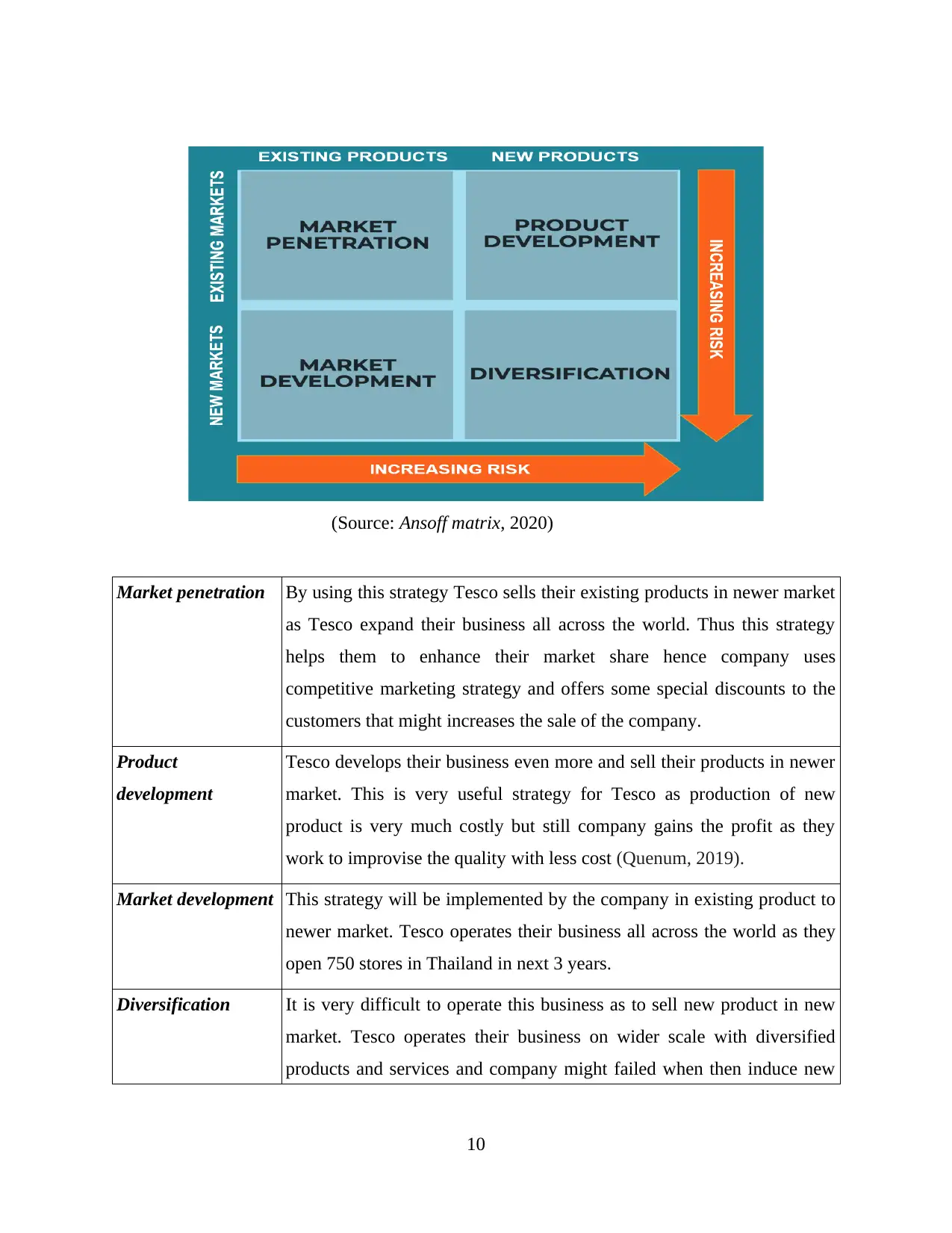
(Source: Ansoff matrix, 2020)
Market penetration By using this strategy Tesco sells their existing products in newer market
as Tesco expand their business all across the world. Thus this strategy
helps them to enhance their market share hence company uses
competitive marketing strategy and offers some special discounts to the
customers that might increases the sale of the company.
Product
development
Tesco develops their business even more and sell their products in newer
market. This is very useful strategy for Tesco as production of new
product is very much costly but still company gains the profit as they
work to improvise the quality with less cost (Quenum, 2019).
Market development This strategy will be implemented by the company in existing product to
newer market. Tesco operates their business all across the world as they
open 750 stores in Thailand in next 3 years.
Diversification It is very difficult to operate this business as to sell new product in new
market. Tesco operates their business on wider scale with diversified
products and services and company might failed when then induce new
10
Market penetration By using this strategy Tesco sells their existing products in newer market
as Tesco expand their business all across the world. Thus this strategy
helps them to enhance their market share hence company uses
competitive marketing strategy and offers some special discounts to the
customers that might increases the sale of the company.
Product
development
Tesco develops their business even more and sell their products in newer
market. This is very useful strategy for Tesco as production of new
product is very much costly but still company gains the profit as they
work to improvise the quality with less cost (Quenum, 2019).
Market development This strategy will be implemented by the company in existing product to
newer market. Tesco operates their business all across the world as they
open 750 stores in Thailand in next 3 years.
Diversification It is very difficult to operate this business as to sell new product in new
market. Tesco operates their business on wider scale with diversified
products and services and company might failed when then induce new
10
⊘ This is a preview!⊘
Do you want full access?
Subscribe today to unlock all pages.

Trusted by 1+ million students worldwide
1 out of 17
Related Documents
Your All-in-One AI-Powered Toolkit for Academic Success.
+13062052269
info@desklib.com
Available 24*7 on WhatsApp / Email
![[object Object]](/_next/static/media/star-bottom.7253800d.svg)
Unlock your academic potential
Copyright © 2020–2025 A2Z Services. All Rights Reserved. Developed and managed by ZUCOL.




